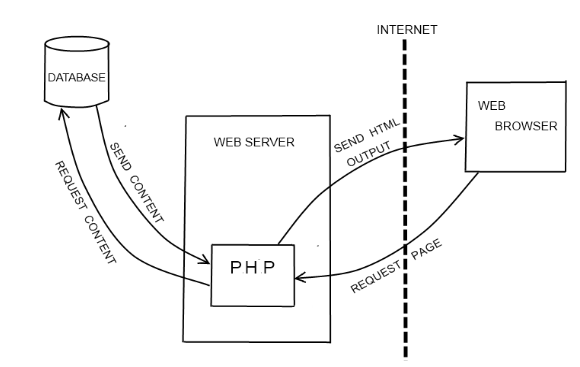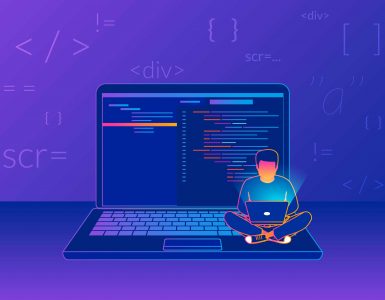In the ever-evolving landscape of software development, programming languages play a crucial role in shaping the way applications are built and run. Among the myriad choices available, two popular languages that often find themselves in the spotlight are PHP and Python. While both languages have their strengths and weaknesses, and selecting the right one depends on the nature of your project and your personal preferences.
In this blog post, we’ll explore the characteristics of PHP and Python, their applications, and compare them to help you make an informed decision.
What is PHP?
PHP, which stands for Hypertext Preprocessor, is a server-side scripting language created in 1995 by Rasmus Lerdorf. It was created with the intent of making web development more accessible and efficient. Its simple syntax and seamless integration with HTML have contributed to its popularity.
As of October 2018, PHP is used on 80% of websites whose server-side language is known. So PHP is used by almost 8 out of 10 websites you visit on the Internet.
It is primarily used on websites to create dynamic web page content.
Use-cases include:
- Websites and web applications (server-side scripting)
- Command line scripting
- Desktop (GUI) applications
Additionally, PHP’s ability to interact with databases makes it an excellent choice for creating e-commerce websites and online forums.

Source: https://github.com/xeroxism/
Applications of PHP
PHP’s domain lies predominantly in web development. It is utilized for building dynamic websites, web applications, and server-side scripting. Many popular content management systems (CMS) such as WordPress, Joomla, and Drupal are powered by PHP.
WordPress: WordPress is written using PHP as the scripting language, and tops the list of most user-friendly and beginner-friendly CMS platforms. It offers a simple and intuitive interface, a large and active community, and thousands of themes and plugins to customize your website. WordPress is ideal for blogs, small businesses, e-commerce, and any type of website that you can imagine.
Joomla: Joomla is a more advanced and flexible CMS platform than WordPress. It has a steeper learning curve, but it also offers more features and functionality out of the box. Joomla is suitable for social networking, community, membership, and e-learning websites.
Drupal: Among the three drupal is the most powerful and complex CMS platform. It has the highest level of technical expertise required, but it also provides the most control and customization options. Which makes Drupal a perfect CMS for large-scale, enterprise-level, and data-intensive websites.
What is Python?
Created by Guido van Rossum in 1991, Python stands as a testament to the power of high-level, interpreted, and object-oriented programming languages. The most recent update, Python 3.9.2, was unveiled on February 19, 2021, marking another step in its evolutionary journey.
This is a versatile, high-level programming language known for its readability and ease of use. Python’s design philosophy emphasizes code readability and its comprehensive standard library provides support for a wide range of functionalities. While initially not as closely tied to web development as PHP, Python has gradually made its way into this domain.
Beyond web development, Python finds extensive application in fields such as data science, machine learning, scientific computing, and automation. The language’s extensive standard library and rich ecosystem of third-party packages empower developers to tackle a diverse range of projects.
Applications of Python
Python is a versatile and powerful programming language that has many applications in the real world. It is widely used in various fields, such as data science, machine learning, scientific computing, and automation.
Some of the most common and popular applications of Python are:
- Web development: Python can be used to create dynamic and interactive websites using frameworks such as Django, Flask, Pyramid, and Bottle. Python also supports many web protocols and formats, such as HTTP, XML, JSON, IMAP, POP, FTP, etc.
- Artificial intelligence and machine learning: In the AI world, it is one of the preferred languages for developing AI and ML models and applications. Python has many libraries and tools that provide functionalities such as data analysis, visualization, statistics, algorithms, etc. Some of the examples are Pandas, NumPy, SciPy, Seaborn, Matplotlib, Scikit-learn, TensorFlow, Keras, etc.
- Game development: For creating fun and engaging games using libraries such as Pygame and Pykyra. Python also supports 3D graphics and scripting for game engines. Some of the famous games that use Python are Battlefield 2, World of Tanks, Toontown Online, and Civilization.
- Desktop GUI development: To create user-friendly and cross-platform graphical user interfaces using libraries such as Tkinter, wxPython, Kivy, PyQt, PySide, PyGUI, etc.
- Enterprise/business applications: It is used to build scalable, extensible, and reliable applications for various business domains and purposes. Some of the examples are Odoo, an all-in-one management software; Tryton, a general-purpose application platform; and SCons, a build control system.
- Software development: Python can also be used as a support language for software developers, for tasks such as build control, testing, debugging, documentation, etc. Python has many libraries and tools that help in these aspects, such as Buildbot, Apache Gump, Roundup, Trac, etc.
Comparing PHP with Python for Choosing the Right Language for Your Project
PHP vs Python: Quick comparison
| Aspect | PHP | Python |
| Primary Use | Server-side scripting language | General-purpose programming language |
| Syntax | Mixed syntax with HTML embedded | Clean, easy-to-read syntax |
| Community | Active community, particularly in web development | Large and active community |
| Popularity | Dominant in web development | Widely used in various domains |
| Ease of Learning | Relatively easy to pick up | Easy to learn and beginner-friendly |
| Versatility | Mainly used for web development | Used for web development, data analysis, automation, AI, etc. |
| Frameworks | Laravel, Symfony, WordPress, etc. | Django, Flask, PyTorch, TensorFlow, etc. |
| Performance | Generally faster due to its interpreter | Generally slower compared to compiled languages |
| Code Readability | Prone to mixing logic and presentation | Emphasizes clean and readable code |
| Error Handling | Less detailed error messages | Comprehensive error messages |
| Database Support | Supports many databases via extensions | Wide range of database libraries and ORMs |
| Web Development | Primarily designed for server-side scripting | Used with web frameworks for backend development |
| Syntax Examples | echo “Hello, world!”; | print(“Hello, world!”) |
| Use Cases | Web applications, dynamic websites, CMS | Web apps, scientific computing, automation, AI |
| Learning Resources | Good documentation, tutorials for web dev | Abundant tutorials, documentation, and courses |
Detailed Comparison PHP vs Python
To explore the contrasting qualities of PHP and Python, two dynamic programming languages that have garnered substantial attention and praise. Rather than a conventional side-by-side comparison, we’ll delve into the unique features and strengths of each language.
When comparing PHP and Python, several factors come into play:
Performance and Efficiency Analysis
When it comes to performance, PHP and Python exhibit divergent characteristics. PHP, being an interpreted language, is often perceived as faster for web-specific tasks due to its optimized execution of web-related functions. On the other hand, Python’s interpreted nature and Global Interpreter Lock (GIL) can pose challenges for multi-threaded applications. However, Python’s extensive libraries and optimization techniques mitigate these concerns, enabling impressive performance in data-centric tasks.
Ecosystems and Communities: PHP and Python
The PHP ecosystem revolves around a plethora of frameworks and libraries that cater specifically to web development. Laravel, Symfony, and CodeIgniter are just a few of the many options available. PHP’s long-standing history has fostered a robust and dedicated community, providing a wealth of resources and support.
Python’s ecosystem is equally vibrant, but its domain extends far beyond web development. Frameworks like Django and Flask facilitate web projects, while libraries like NumPy, Pandas, and TensorFlow drive Python’s dominance in data science and machine learning. Python’s community, known for its inclusivity and willingness to help, contributes to the language’s rapid growth and adaptability.
Learning Curves and Accessibility
PHP’s relatively straightforward syntax and its close relationship with HTML make it an accessible language for beginners. This simplicity reduces the learning curve, enabling newcomers to quickly grasp the fundamentals of web development.
Python’s elegant and human-readable syntax also contributes to its beginner-friendliness. Its clear and concise code structure allows new programmers to focus on problem-solving rather than deciphering complex syntax rules.
Future perspectives
Predicting the future of programming languages is a challenging task, but certain trends give insight into the trajectories of PHP and Python. PHP’s historical significance in web development suggests its continued relevance, particularly within the realm of content management systems and e-commerce platforms.
Python’s trajectory is equally promising. Its role in data-driven technologies, artificial intelligence, and scientific research positions it as a cornerstone of future technological advancements.
Conclusion
There is no clear winner in the PHP vs Python comparison, as both languages have their strengths and weaknesses. The best choice depends on your personal preference, project needs, and available resources. Consider your project’s scope, your team’s expertise, and the specific features you need when making your decision.
You can also use both languages together in some cases, such as using PHP for the front-end and Python for the back-end. Ultimately, the most important thing is to choose a language that you enjoy working with and that helps you achieve your goals.
Happy coding!
Frequently Asked Questions (FAQs)
Q: What are the major differences between PHP & Python?
The major differences include their primary design purposes (web development vs. general-purpose programming), syntax styles, and the ecosystems of libraries and frameworks available.
Q: What are the similarities between PHP & Python?
Both languages are high-level, dynamically typed languages with active communities and extensive libraries. They are used to build a wide range of applications and can interact with databases.
Q: Which is better, PHP or Python?
Neither language is objectively better than the other. The choice depends on your project’s requirements and your familiarity with the language. PHP is a strong choice for web development, while Python’s versatility suits a broader range of applications. In the end, both PHP and Python have their unique strengths and applications. By understanding their characteristics and evaluating your project’s needs, you can make an informed decision that aligns with your goals and expertise.
Q: What are the career opportunities for PHP and Python developers?
PHP developers often find opportunities in web development and PHP-based CMS platforms. Python developers have a broader range of career opportunities, including web development, data science, machine learning, and scientific computing.






Add comment